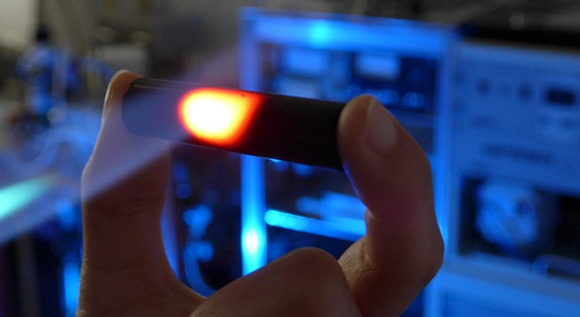Innovative thermal insulation for high-temperature furnaces
An airhead becomes a super insulator: air accounts for more than 90% of the volume of carbon aerogels. In future, these aerogels could more than double the thermal insulation efficiency of high-temperature furnaces. The AeroFurnace research project is studying what the lightweight substances can do.
 © ZAE Bayern
© ZAE Bayern
A lot of manufacturing processes in energy-intensive industry need temperatures of more than 1,500 Celsius – e.g. to make steel or ceramics. Wherever that sort of temperature is used, the surrounding area should stay nice and cool – as little heat as possible should be lost. The better the insulation, the less energy is needed to heat up the furnace and – of particular importance – to maintain the temperature inside the furnace.
The AeroFurnace research project is now developing a new composite material which could more than double the heat insulation efficiency in comparison to that of existing materials. This nanoporous carbon material could thus significantly cut the energy needs of specialised high-temperature furnaces. At the same time, the insulation doesn’t need to be thicker, which would reduce the useful volume of the furnace. At present, felt-based carbon materials are used in a zero-oxygen environment to insulate these high temperatures.
Dr Gudrun Reichenauer is coordinating the research project and heads the Nanomaterials Working Group at the Bavarian Center for Applied Energy Research. She is very encouraged by the results so far: 'In this project, we have been able to make the latest findings from the world of nanomaterials accessible to the market through intensive cooperation and thus set new standards in the field of thermal insulation materials,' she says.
Nanoporous carbons for more energy-efficient thermal insulation
Thermal insulation materials in blast furnaces need to be able to withstand the extreme heat without any problems. Previously, this has only been achieved by insulating materials which are also highly conductive of heat, i.e. which are good at transmitting heat. That is bad for energy efficiency. For this reason, the team of scientists is working on a specific group of materials: carbon aerogels, which offer particularly low heat conductivity. Aerogels can be made from various materials, such as silicates, metals and their oxides, polymers, biopolymers and carbonates. They are so porous that more than 90% of them consists of air or free space. This makes them very light. They are of low density, have a large internal surface and extremely low heat conductivity, and can help to make sparing use of natural resources like energy from natural gas and oil.
Dr Thomas Kirschbaum, AeroFurnace project leader at carbon manufacturer SGL Carbon, believes that the new insulating material has a great future: 'In furnace simulations at the partner FCT, we have already been able to demonstrate what the new material can do: depending on the temperature programme, up to 40% of the required process energy can be saved with the new thermal insulation material. The potential of the new material is great.'
The carbon aerogels used in the AeroFurnace Project offer another advantage: their carbon nanostructure absorbs most of the heat radiation, which is chiefly responsible for transporting heat at high temperatures. For example, they can be used as super-insulating materials in particularly challenging fields, such as the automotive industry, insulation systems for buildings, and high-temperature applications.
New insulating material being tested in high-temperature furnaces
In the AeroFurnace research project, the scientists have already found out that the manufacture of the new thermal insulator can be mapped in the laboratory using simple technical processes, and can easily be scaled up. However, there is still a long way to go before the material can be used on an industrial scale.
Before the new materials can make their market breakthrough, we will need to know that they work in industry. However, studies under real-life conditions cannot be undertaken until the relevant manufacturing process can be implemented on a larger scale. The research funding is enabling the groups working on the project to tackle both tasks in parallel.
In the second half of the research project, the team of researchers aims to test the newly developed thermal insulation material in a high-temperature furnace and to compare it with a furnace of the same design which uses conventional insulation. As so as the manufacture of the new aerogel types has been tested sufficiently, their uses could also be trialled in other areas with a view to developing new products.
Aerogel clusters – from the research lab to the market
In order to advance the widespread use of aerogels in industry, several research projects funded by the Federal Ministry for Economic Affairs and Energy – including the AeroFurnace research project – have joined forces in the aerogel cluster.
The research cluster aims to develop a long-term strategy for the successful market launch of aerogels. Scientists say that there is a great deal of potential, because aerogels combine numerous characteristics in a way that no other class of material does: a high level of sound absorption with low heat conductivity and a low density with a large internal surface which makes them extremely light and pressure-resistant. So there are good prospects for the production of high-quality aerogels to pick up speed for use in a wide variety of applications.
The Federal Ministry for Economic Affairs and Energy is providing the AeroFurnace project with approximately €625,000 over a period of three and a half years.
Further information
- Description of the various sub-projects on the EnArgus energy research website (in German only)
- Information about the research project on the energy research website for industry (in German only)
- SGL Carbon press release on progress in the project
- Information about the aerogel cluster
- Information on energy efficiency research in the chemical industry (in German only)

